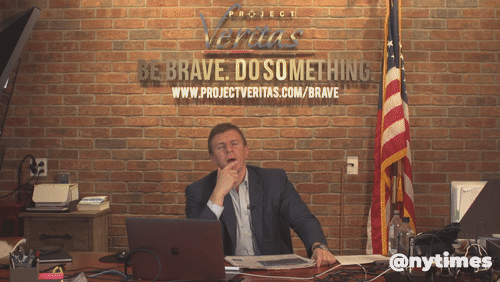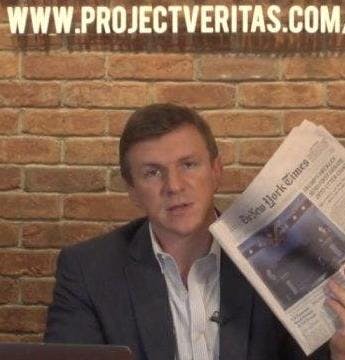
James O’Keefe Demands New York Times Retract Hit Piece on Veritas’ Minnesota Ballot Harvesting Investigation … ‘We Are Not Afraid of The New York Times Or Anyone Else’…‘We Will Have Our Day In Court, And We Will Win’
Key Points
James O’Keefe: NYT Claim Project Veritas “Probably Coordinated Release with Trump Campaign Is Bullsh#t”
O’Keefe: New York Times Reporter Maggie Astor Never Contacted Project Veritas
O’Keefe: Astor Wrongly Wrote Minnesota Had No Limit on Harvested Ballots
O’Keefe: Nothing in Article Substantiated Claim Video Was “Deceptive”
[WESTCHESTER COUNTY, N.Y.—Oct. 11, 2020] The founder and CEO of Project Veritas demanded today that The New York Times correct its reporting that Project Veritas’ Minnesota ballot harvesting investigation was part of a “coordinated disinformation effort” with President Donald Trump’s reelection campaign.
“On Tuesday, Sept. 29 online and Wednesday Sept. 30 in the print edition, The New York Times published an article falsely claiming in its headline: ‘Project Veritas Releases Misleading Video, Part of What Experts Call a Coordinated Effort,’” said James O’Keefe, who made his points this this video below.

“The article is libelous, unsubstantiated, misleading and is full of fabricated claims,” O’Keefe said.
“Who took my New York Times? Not my actual newspaper, but the newspaper my father used to read—it was honest, reliable and for the most part unbiased—sadly, someone took that New York Times and replaced it with this sad imposter,” he said.
O’Keefe: The New York Times has no documentation to back up its claim that there was coordination
Astor asserted that Project Veritas planned to release its Minnesota ballot harvesting story Monday Sept. 28 but changed the release because of her paper’s story about Trump’s taxes—based on a report done by researchers at Stanford University on the virality of the video’s release.
Astor wrote: “Project Veritas released it Sunday instead, a few hours after the publication of the The Time’s investigation.”
O’Keefe said this assertion was false.
“The article goes on in the first paragraph to say the video was ‘probably part of a coordinated disinformation effort,’” O’Keefe said.
O’Keefe said Astor’s characterization as deceptive was unfounded.
“The second word of the article about our Minnesota ballot harvesting investigation calls the video ‘deceptive,’ but there is nothing in the article to substantiate this libelous claim,” he said. “In fact, the video speaks for itself and is very clear.”
In the Project Veritas video released Sept. 27, the most damning segment includes videos posted by ballot harvester Liban Mohamed, also known as Liban Osman, on his personal Snapchat account. In the video, Liban brags about having 300 ballots in his car.
Minnesota law prohibits individuals from having more than three ballots. A district judge suspended enforcement of the three-ballot limit pending a court-challenge to the law, which meant that the ballot harvesters, such as Liban, exceeded the three-ballot limit at their own risk.
When the state’s high court affirmed the law in a Sept. 4 ruling, it meant that everyone who exceeded the three-ballot limit was in legal jeopardy.
Reporter did not reach out to O’Keefe nor Project Veritas for comment
O’Keefe said neither the reporter Maggie Astor, nor anyone else from the paper contacted him or Project Veritas to confirm their assertions.
“The Times article says evidence of the ‘coordinated disinformation effort’ was based on when Project Veritas released the ballot harvesting tapes,” he said.
“Had The Times or the ‘researchers’ done any due diligence by contacting Project Veritas, we could have undeniably proven the decision to release the video early was made before The Times article was published,” he said.“
To be absolutely clear, the Project Veritas decision on the timing of the release had nothing to do with The Times,” O’Keefe said.
“This is just total BS. The source for this outrageous claim is some ‘researchers’ making conspiracy theory conclusions based on a series of false and unsupported assumptions relying on tweets and posts promoting the Project Veritas video,” he said. “This is hack reporting and should be beneath The New York Times.”
Unlike the article Maggie Astor wrote, the Project Veritas report relies heavily on named sources, O’Keefe said.
“Many of the people in the video are clearly named and clearly visible,” he said. “You can hear their voices. You can see their faces. You can hear their intonations.”
Project Veritas sent a letter to the paper demanding a retraction,” O’Keefe said. “The New York Times response? They say they stand by their reporting.”
Second Project Veritas letter seeks redress, demands editors, reporters and other preserve documents
O’Keefe said Project Veritas sent a second letter to The Times to reiterate the mistakes in the article about the Minnesota ballot harvesting story.
Speaking directly to the paper’s leadership in a video released today, O’Keefe said: “Our only recourse if you do not retract is to sue you.”
In the second letter, Project Veritas put editors, reporters and anyone else associated with the production of the article on notice that they had to preserve and retain all of their documents, data and electronically stored materials, he said.
“I am not afraid of The New York Times,” he said.
“We are not afraid of The New York Times or anyone else, who defames us or who defames our work. We will have our day in court, and we will win.”
About Project Veritas
Project Veritas is a non-profit investigative news organization conducting undercover reporting. Project Veritas investigates and exposes corruption, dishonesty, self-dealing, waste, fraud, and other misconduct in both public and private institutions to achieve a more ethical and transparent society. Project Veritas is a registered 501(c)(3) organization.
